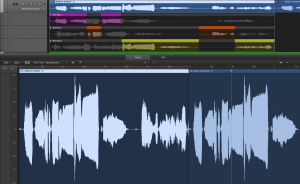9 Steps to Achieving Balanced Sound Levels in Your Video Projects
Unless you’re producing a silent film, your sound needs to meet all the criteria for an increasingly AV-fickle audience. Any sound technician will tell of the myriad of factors to consider when incorporating sound into a video project. However, in this article, we’ll focus on achieving audio balance so it complements your videography.
Follow the nine steps outlined below when including voice-overs, dialogues, music, or sound effects in your video projects:
-
Select High-Quality Equipment
 When selecting quality sound equipment for your videos, ensure that the hardware and software are easily coupled and compatible and that you can use the features without too much hassle. It’s also essential to assess their setup ease and configuration flexibility for different recording scenarios.
When selecting quality sound equipment for your videos, ensure that the hardware and software are easily coupled and compatible and that you can use the features without too much hassle. It’s also essential to assess their setup ease and configuration flexibility for different recording scenarios.
Here are some factors to consider when selecting equipment for optimal audio capture and sound levels:
- Get a high-quality microphone tailored to your specific needs, such as a shotgun mic for directional recording or a Lavalier mic for hands-free operation.
- Choose a recording device with sufficient features, e.g., adjustable input levels and low noise preamps.
- Invest in monitoring headphones to accurately assess the audio recording.
- Research and invest in reputable brands known for their reliability and performance.
-
Understand the Fundamentals of Audio Sound Levels
Without knowledge of basic audio concepts, recording sounds for videos will be hit-and-miss. However, understanding these concepts helps with your setup and editing, allowing you to work smarter (not harder) to produce perfectly balanced audio accompaniments.
Here are some examples of audio fundamentals required for creating immersive and professional videos:
- Key terms to grasp include amplitude (volume), frequency (pitch), and dynamics (the range between loud and soft sounds).
- You can manipulate audio elements by adjusting volume levels and utilising equalisation (EQ) to balance frequencies.
- Background noise will impact the dialogue clarity.
- Compression helps to control dynamic range.
- Sound effects and music help to create an atmosphere.
- Digital Audio Workstations (DAWs) are helpful in post-production editing.
-
Set Up a Controlled Environment
When it’s time to record your video, you must prepare the environment to achieve the best sound levels quality possible.
Follow these tips to help you organise the recording environment:
- Choose a quiet location and schedule recording sessions during low-traffic periods to minimise ambient noise.
- Use appropriate acoustic treatments to control sound reflections and echoes and create an acoustically favourable space.
- Consider using soft furnishings and curtains to absorb sound if possible.
- Properly position microphones to capture clear audio while minimising unwanted environmental sounds.
- Test the acoustics in the room and fix any issues before recording commences.
- Ensure the recording space is as comfortable and distraction-free as possible for the performers and speakers.
-
Adjust Audio Input Sound Levels
Another way of ensuring optimal sound quality in your videos is to adjust the audio input levels during recording. Set appropriate input levels on your recording device, avoiding too low and too high. The chosen level should capture the full dynamic range of your audio recording without distorting it.
Here are other considerations for adjusting audio input levels:
- Be attentive to peaks during recording, ensuring they don’t clip and distort the audio.
- Experiment with different input levels during test recordings to find the ideal balance.
- Adjust input levels as necessary (especially during loud and soft parts) to ensure a consistent and well-balanced audio output for your video projects.
-
Utilise Editing and Mixing Techniques
After recording, you must edit the audio to ensure it’s polished and professional. For these post-production tasks, you would need a DAW. Here are some editing and mixing techniques to try:
- Edit audio clips by removing unwanted noise, pauses, and mistakes.
- Use EQ to balance the frequencies and enhance clarity, ensuring each element occupies its sonic space.
- Use audio compression to control dynamic range, making softer sound levels more audible and louder sounds less distorted.
- Experiment with panning to create a sense of space and directionality in the audio.
- Layer sounds and music judiciously, adjusting their volumes to complement rather than overpower the dialogue.
- Monitor your mix and use reference tracks to maintain a balanced and consistent sound throughout the video.
-
Focus on the Dialogue Quality in Videos
When recording a dialogue, you have a few more variables to consider. For high-quality dialogue recordings, do the following:
- Prioritise clear and intelligible speech by choosing the correct microphone.
- Minimise background noise to enhance the clarity of spoken words.
- Use windshields or pop sounds to reduce plosive sounds and sibilance.
- Edit out pauses and consider EQ and volume consistency.
- Synchronise audio with video to avoid lip-sync issues.
-
Incorporate Sound Effects and Music Thoughtfully
When adding sound effects and music to your videos, remember that a well-integrated audio experience can elevate your video’s production value while creating a more engaging viewer experience. Here’s what you can do to thoughtfully incorporate sound effects and music to improve sound levels:
- Choose audios that complement the visuals, not detract from the dialogue or message.
- Use music and sound effects that enhance the narrative and align with a scene’s tone and emotion.
- Adjust volume levels, use transitions and fades, and synchronise sound effects with on-screen actions.
- Be mindful of copyright considerations.
-
Test and Fine-Tune Your Audio Balance Regularly
Testing and fine-tuning the sound levels settings in your video production is a continuous, iterative process. Regularly monitor and assess the audio quality at different stages of your project as follows:
- Pre-production: Conduct initial tests before major recording sessions to address issues and select optimal settings.
- Recording: Check sound levels and monitor for unexpected noises or technical issues.
- Post-production: Consistently review and fine-tune audio elements, adjusting levels, EQ, and other settings as needed.
Additionally, seek feedback from colleagues and collaborators, as fresh perspectives can help to identify areas requiring balancing. Then, before finalising your video, conduct thorough quality checks to ensure a polished and cohesive audio-visual experience.
-
Ensure Proper Sound Mixing and Mastering
Ensuring proper sound mixing and mastering in your video project means adopting a meticulous approach throughout post-production. Follow these steps in your mixing and mastering process:
- Organise your tracks logically within a DAW, ensuring clarity and ease of navigation.
- Use EQ to balance frequencies, compression to control dynamic range, and panning for spatiality and directionality if required.
- Adjust music and sound effect volumes judiciously so they don’t overpower or detract from dialogue.
- Monitor and compare your mix to reference tracks as often as necessary, your sound levels will benefit.
During the mastering phase, focus on the overall cohesion of the audio, adjusting the appropriate sound levels and applying final touches to ensure a polished and professional sound. Remember, the goal is to aim for a balanced mix of audio that enhances the narrative and engages the viewer. Therefore, consider seeking feedback from others to refine the final product.
Conclusion
Many of the steps for achieving balanced sound levels overlap or may seem repetitive, but they’re all part of the iterative process of fine-tuning all aspects of the audio to complement the visuals. By following them all, you can create the best possible audio experience for your viewers.

Recent Comments